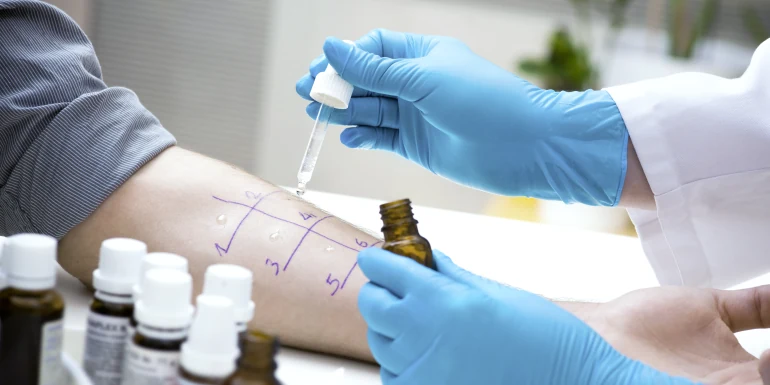
Penicillin allergy: what can be done?
How do you recognise a penicillin allergy, and can a penicillin allergy go away? What can you do if you have a penicillin allergy? Learn all you need to know about a penicillin allergy and the possible symptoms of penicillin intolerance.
What is a penicillin allergy?
A penicillin allergy is when your immune system overreacts to the antibiotic penicillin (or, in some cases, it overreacts to related antibiotics). Your immune system incorrectly identifies this substance as a threat and produces antibodies as a form of defence. This reaction causes allergic symptoms.
There are two different types of penicillin allergies, and they cannot always be clearly distinguished from each other:
- Immediate-type allergy: this is an acute allergy. It typically occurs within one to two hours after you have ingested the active ingredient.
- Delayed-type allergy: the immune system produces antibodies that form complexes with the penicillin, or certain cells specifically target the substance. Both reactions can trigger inflammatory reactions in the body, which you often only notice days after taking the medication – sometimes even several days after you stop taking the medication.
Being allergic to penicillin limits your treatment options for bacterial infections, so it is important to know whether you are allergic to this substance or not. Should you suspect that you are allergic to penicillin, consult your doctor.
Penicillin allergy: what are the symptoms?
A penicillin allergy can trigger various symptoms. The type of symptoms varies from person to person and depends on the individual’s immune system response. Some of the most common symptoms are:
- Skin rash and itching: a penicillin allergy commonly causes a skin rash. This appears in the form of red, itchy patches or bumps on the skin. It is important to distinguish whether the rash appears within hours (often a reaction while healing) or only after a few days (usually harmless, unless blisters form or the mucous membranes are affected).
- Swelling: penicillin allergy sufferers often experience facial swelling after taking this active ingredient. The swelling mainly affects your lips and the area around your eyes.
- Fever: an increase in body temperature is another possible symptom of a penicillin allergy. Fever can develop when your immune system reacts to the penicillin and triggers inflammatory reactions. This symptom may be accompanied by you generally feeling unwell and having chills.
- Breathing difficulties and coughing: severe allergic reactions to penicillin can lead to breathing difficulties. This can manifest itself in you being short of breath or having a persistent cough.
- Diarrhoea and vomiting: some sufferers experience gastrointestinal symptoms such as diarrhoea and vomiting.
- Seizures: a severe penicillin allergy can lead to seizures.
- Cardiovascular complaints: penicillin allergies can also affect the cardiovascular system and lead to symptoms such as tachycardia or a drop in blood pressure.
Some of these symptoms can also cause you to suffer anaphylactic shock. This is a serious life-threatening reaction that requires immediate medical attention. A penicillin allergy is particularly dangerous in this case. Symptoms of anaphylactic shock can include breathing difficulties, palpitations, a sudden drop in blood pressure and unconsciousness.
Important: consult a doctor immediately if you experience any of these symptoms after taking penicillin.
Penicillin allergies: how common are they?
The rates of penicillin allergy vary by geographic region and population group. It is one of the most commonly reported drug allergies. Many people think they are affected by this allergy because they experience mild symptoms such as diarrhoea or feel no improvement in infection symptoms after taking penicillin. However, this assumption is often not confirmed. In general, people suspect they have penicillin allergies much more frequently than they actually do. So before stating that you have a penicillin allergy, you should discuss this with your doctor and, if necessary, have an allergy test carried out. This is because, if you incorrectly declare an allergy, you may have to take less effective medication even though you in fact can tolerate penicillin.
In young children, a penicillin allergy often manifests itself as a skin rash, itching or breathing difficulties. As younger patients cannot always clearly communicate their symptoms, it is important to look out for signs of them developing an allergic reaction, especially after taking antibiotics. If an allergy is suspected, doctors will conduct a careful assessment, taking account of the child’s health and growth development.
A penicillin allergy also has an impact on pregnancy. Pregnant women who are allergic to penicillin need safe alternatives to minimise the risk to mother and child. Before taking penicillin while pregnant, you should therefore determine whether you are allergic to penicillin. Your doctor will inform you about possible courses of action.
Penicillin allergy: how is it diagnosed?
If a penicillin allergy is suspected, and especially if there are severe symptoms such as shortness of breath, circulatory problems or skin blistering, it is essential to obtain a clear diagnosis. Your doctor will use an allergy test to establish whether you can tolerate penicillin or not. The procedure varies depending on the diagnostic procedure chosen. Your doctor will decide which procedure is most suitable for you.
The allergy tests used for possible penicillin allergy include skin tests, laboratory tests and provocation tests.
- Skin test: here, doctors use the prick test. They apply a small amount of the allergen – in this case penicillin – to the skin, usually on your forearm. They then make a tiny puncture to allow the allergen to penetrate the skin.
- Laboratory test: blood tests can also be used to test for a penicillin allergy. Doctors use the IgE test, for example, which measures the level of immunoglobulin E (IgE) in the blood. IgE is an antibody involved in allergic reactions. The test looks for specific IgE antibodies that react to penicillin. A raised IgE level for penicillin may indicate an allergy. More laboratory tests can analyse how your blood cells react to the medication.
- Provocation tests: an antibiotic is administered as a tablet or infusion. This test is used if your medical history and other tests are inconclusive. Doctors can also use the provocation test to check whether you can tolerate a certain medication as an alternative to penicillin.
What should you do if you have a penicillin allergy?
Being allergic to penicillin is challenging for many sufferers. However, there are many ways to treat a penicillin allergy.
If a penicillin allergy is diagnosed, the first step is to avoid this active ingredient. There are a number of substitute antibiotics that you can use if you are allergic to penicillin. Other antibiotic agents are often used for treating penicillin allergy with antibiotics: for example, cefuroxime can be used by people with most types of penicillin allergy. However, treatment using the active ingredient amoxicillin is not recommended in many cases of penicillin allergy, as this active ingredient belongs to the penicillin family.
Your doctor can tell you which antibiotics are suitable for a penicillin allergy. They will also identify whether your penicillin allergy is associated with a cross-allergy. If you have a cross-allergy, your body reacts similarly to structures contained in penicillin and the substitute antibiotic. That is why a thorough medical investigation is essential before using alternatives if you are allergic to penicillin.
Tip: if you suffer from this allergy, wear a penicillin allergy bracelet. In an emergency, this quickly tells medical staff that you have an allergy.
If there is any chance that you are allergic to penicillin, talk to your doctor about it. They will decide whether it makes sense to have an allergy test and will help you with the diagnosis and treatment.

This specialist provided the editorial team with expert advice and input for this article. Peter Schmid-Grendelmeier is head of the allergy department of the Dermatology Clinic at the University Hospital in Zurich. He specialises in allergies of all kinds, including neurodermatitis and urticaria (hives, nettle rash), tropical and travel dermatology and histamine-mediated diseases.


Newsletter
Find out more about current health issues every month and get all the information you need about our attractive offers from all Helsana Group companies * delivered by e-mail to read whenever it suits you. Our newsletter is free of charge and you can sign up here:
We did not receive your information. Please try again later.
* The Helsana Group comprises Helsana Insurance Company Ltd, Helsana Supplementary Insurances Ltd and Helsana Accidents Ltd.